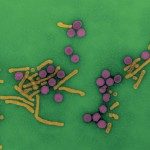Lien vers Pubmed [PMID] – 23201222
Bone 2013 Mar;53(1):6-12
Wnt signaling is an important pathway that controls the osteogenic differentiation of mesenchymal stromal cells (MSC). We previously showed that FHL2, a LIM-only protein with four and a half LIM domains, controls MSC osteogenic differentiation via the canonical Wnt/β-catenin signaling. In this study, we investigated the role of Wnt proteins in the regulation of MSC differentiation by FHL2. We found that Wnt3a increased FHL2 mRNA expression in murine C3H10T1/2 mesenchymal cells. Silencing FHL2 using short hairpin (sh) RNA attenuated β-catenin transcriptional activity and osteogenic differentiation induced by Wnt3a. In addition, FHL2 silencing reduced the expression of the key molecules Wnt5a and Wnt10b and osteoblast gene expression. Wnt10b overcomes the negative effect of FHL2 knockdown on osteoblast gene expression in vitro. To confirm this finding in vivo, we analyzed the expression of these Wnt molecules in FHL2 deficient mice. Histomorphometric analyses showed that FHL2 knockout decreased trabecular number and thickness and reduced bone mass in 15-month old mice. This phenotype was associated with decreased Wnt5a and Wnt10b and lower than normal c-myc, cyclin D1 and osteoblast gene expression in the bone marrow. Ex vivo analysis showed decreased basal and Wnt3a-induced Wnt5a and Wnt10b mRNA expression in FHL2-deficient bone marrow cells, further indicating that this defect may contribute to the reduced osteoblast function in FHL2 deficient mice. In contrast, the decreased adipogenesis induced by FHL2 deficiency in vitro and in vivo was linked to increased Foxo1 expression. Collectively, the results provide evidence for a previously unrecognized mechanism by which FHL2 controls the osteogenic differentiation of MSC, bone formation and bone mass through modulation of Wnt molecules.

